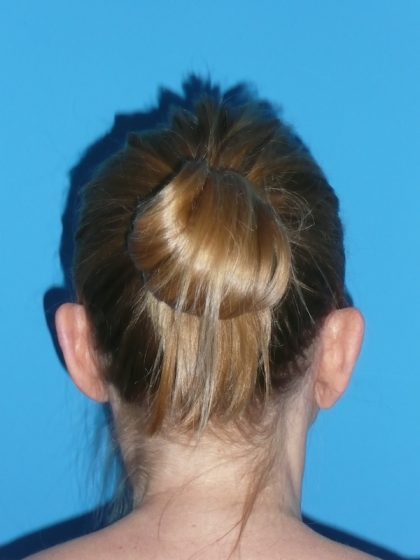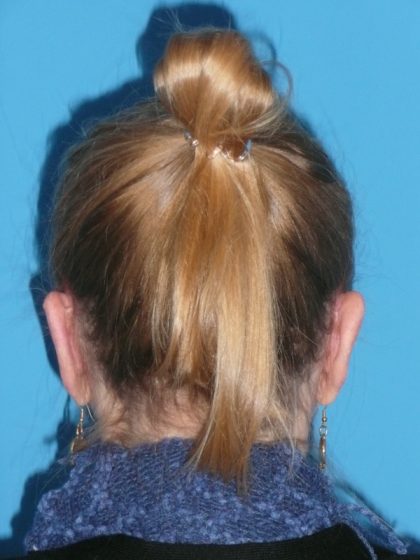Otoplasty
Offered at our convenient location in Baltimore, Maryland
Otoplasty, also known as ear surgery, is a procedure that addresses various concerns related to the appearance of the ears. Whether it’s correcting prominent ears, reducing the size of the earlobes, or reshaping and reconstructing the ears to correct deformities, otoplasty offers patients the opportunity to enhance the aesthetics of their ears and improve their overall facial harmony.
Double board-certified Baltimore-area plastic surgeon Dr. Alyson Wells offers first-class otoplasty procedures at Valley Plastic Surgery and Medi-Spa. For more information, call (410) 628-8200 or contact us online.
Contents
Before and After Photos
About Otoplasty
The ear is an intricate and essential feature of our facial anatomy. However, some individuals may feel self-conscious or unhappy with the appearance of their ears due to various factors such as genetics, trauma, or developmental abnormalities. Otoplasty offers a transformative solution for those seeking to enhance the aesthetics of their ears.
Surgeons operate on the auricle, the outer part of the ear, which is made up of flexible cartilage and skin. The auricle begins development in the womb and continues to change as a person matures into adulthood. Sometimes, the auricle can develop into abnormal shapes, lie awkwardly on the head, or stick out too far. This can cause self-esteem issues and related psychological stress. (1) Luckily, otoplasty can help to address this issue.
Otoplasty may encompass one of the following.
Ear Pinning
Sometimes ears can develop at an angle that extends outward and away from the head. This condition is often called prominauris, or protruding ears. Ear pinning can reposition the ears so that they hug the head tighter and appear more discrete. This is the most common reason for otoplasty. (2)
Ear Augmentation
Some people have ears that are overly small or underdeveloped compared to the size of their head. Ear augmentation can increase the size of the outer ear to solve this problem.
Ear Reduction
Having oversized ears is a condition called macrotia. Macrotia, like other defects of the outer ear, can negatively affect one’s appearance, as it throws off the proportionality of the head. Ear reduction can make the ears smaller, reducing them to a size that is more harmonious with a person’s head proportions.
Benefits of Otoplasty
There are several benefits of otoplasty. These include:
- Improved self-confidence: Otoplasty can have a profound impact on your self-esteem, allowing you to feel more confident and comfortable in social settings.
- Restored facial symmetry: Otoplasty not only improves the appearance of the ears but also helps restore facial symmetry, creating a more proportionate and balanced look.
- Reduced psychological distress: Otoplasty can alleviate the psychological distress often associated with ear deformities, helping you feel more at ease and content within yourself.
- Eliminated social stigma: For individuals who have faced teasing or bullying due to prominent or misshapen ears, otoplasty can eliminate the social stigma associated with these conditions, allowing you to embrace a more positive social experience.
- Improved overall quality of life: The transformative effects of otoplasty extend beyond physical appearance, positively impacting emotional well-being and overall quality of life.
Who is a Candidate for Otoplasty?
Otoplasty for Children
Patients should be at least five years old to receive an otoplasty. This is because the outer ear is about 90% developed by that time, so parents and guardians can make informed decisions about their child’s health and well-being. If your child has noticeable ears, otoplasty could make a major difference in their quality of life. For a young person, an otoplasty procedure could help to prevent years of self-consciousness and bullying.
Otoplasty for Adults
To be considered a good candidate for otoplasty, you should be in good health. Your body needs to be able to heal itself properly so that you can recover optimally. You should also have realistic expectations about what fixing your ears can do for your appearance. We offer a wide variety of cosmetic procedures at Valley Plastic Surgery and Medi-Spa, and one or more of our facial or body enhancement treatments could help bring you even closer to your aesthetic goals.
Personal Consultation
At your consultation, we will provide you with all the information you need about ear surgery. We will happily answer any questions you might have about this treatment. We will ask you about your medical history and assess your ears to formulate an individualized treatment plan. We will discuss your beauty goals, let you know how to prepare, and inform you on what to expect moving forward. To schedule your consultation to discuss otoplasty, call (410) 628-8200 or fill out this inquiry form.
Preparation
To prepare for your otoplasty procedure, we will give you personalized instructions. Follow these instructions closely, as proper preparation will help to ensure that your treatment is a success. We may ask that you stop or start taking certain medications. You should stop taking medications that thin the blood, such as aspirin, ibuprofen, and certain herbal supplements as they can lead to excess bleeding during surgery. For the day of your procedure, you should arrange a ride to and from our facility.
Otoplasty Procedure
Otoplasty is an outpatient procedure. Depending on the techniques that Dr. Wells plans to use, it could take from one to three hours to complete. On the day of your procedure, we will administer either local or general anesthesia, depending on a variety of factors that we will have discussed with you beforehand. We recommend that younger patients receive general anesthesia to avoid discomfort.
When you are prepped for surgery, Dr. Wells will make an incision on the back of your ear or within its folds. Once she has access to the cartilage, she will begin making changes. The exact details of this procedure will depend upon the type of otoplasty you are receiving. She may remove or reshape the cartilage, for an ear reduction or an ear pinning. She may also graft additional cartilage onto your ear for an ear augmentation. When she has completed work on the cartilage, she will close the incisions and your treatment will be complete.
Recovery
Immediately following your procedure, your ears will be dressed for the initial healing process. Be sure to keep these dressings clean and dry. Throughout your recovery, avoid touching your ears. When you sleep, try to lie in a position that does not put undue pressure on the ears. It may also be helpful to wear button-up or zipper tops, as pulling collars over your ears may cause irritation or damage. You may experience some redness, swelling, itching, bruising, numbness, and tingling while you recover which will subside in a few days. We can prescribe medication to help alleviate these symptoms. We will let you know when you should resume daily activity and strenuous exercise.
Results
Once your dressings are removed, you will see an immediate difference in the appearance of your ears. Some swelling may remain for a few months, but the change in size, position or shape will be noticeable. You will finally have the ears that you’ve always wanted. The results of your otoplasty will be permanent, although subsequent corrective surgeries are possible, depending on the nature of your otoplasty.
To learn more about the procedures we offer at Valley Plastic Surgery and Medi-Spa, visit our blog.
How Much Does Otoplasty Cost in Baltimore?
If you’re considering ear surgery, we invite you to contact us at (410) 628-8200 to schedule a consultation with Dr. Wells. Alternatively, you can visit our contact page to learn more. Take the first step towards achieving the ear shape and symmetry you desire by entrusting your care to our expert team.
FAQ
What can ear surgery do?
Ear surgery corrects visual abnormalities of the ear. It can address ears that stick out too far, reduce the size of large ears, and make smaller ears larger. It can also fix the shape of underdeveloped ears or ears that have been damaged by trauma. It involves a surgeon removing, reshaping, or adding cartilage to the outer ear.
What does recovery from ear surgery look like?
Swelling from an otoplasty procedure can take up to two weeks to subside, and three weeks for sensitivity to decrease. Patients wear a dressing that applies pressure to the ears to hold them in their new shape. It is important to avoid sleeping on your side during the healing process, along with other activities that could apply excessive pressure and affect the results.
When will I see the results of my ear surgery?
You will be able to see the results of your otoplasty as soon as you take your protective dressing off. Make sure that you keep the dressing on for as long as your doctor recommends, to ensure that your ears can set in their new shape and position. There will be some swelling for a few weeks, but your ears will still be noticeably improved immediately after surgery.
References
- Naumann A. Otoplasty – techniques, characteristics, and risks. GMS Current Topics in Otorhinolaryngology, Head and Neck Surgery. 2008;6:Doc04. https://www.ncbi.nlm.nih.gov/pmc/articles/PMC3199845/
- Kennedy KL, Katrib Z. Otoplasty. PubMed. Published 2021. https://www.ncbi.nlm.nih.gov/books/NBK538320/















